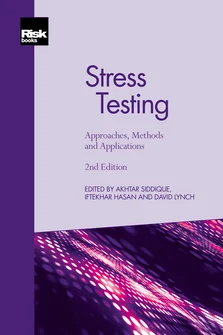Stress-testing applications of Machine Learning Models
Foreword
Introduction
Response to Financial Crises: The Development of Stress Testing over Time
Stress Testing and Other Risk Management Tools
Econometric Pitfalls in Stress Testing
Stress-testing applications of Machine Learning Models
Four Years of Concurrent Stress Testing at the Bank of England: Developing the Macroprudential Perspective
Stress Testing for Market Risk
The Evolution of Stress Testing Counterparty Exposures
Liquidity Risk: The Case of the Brazilian Banking System
Operational Risk: An Overview of Stress-testing Methodologies
Peacetime Stress Testing: A Proposal
Stress-test Modelling for Loan Losses and Reserves
A New Framework for Stress Testing Banks’ Corporate Credit Portfolio
EU-wide Stress Test: The Experience of the EBA
Stress Testing Across International Exposures and Activities
The Asset Market Effects of Bank Stress-test Disclosures
An Alternative Approach to Stress Testing a Bank’s Trading Book
Determining the Severity of Macroeconomic Stress Scenarios
Governance over Stress Testing
This chapter will discuss stress-testing applications of machine-learning methods against the background of forecasting accuracy, interpretability of results, and the ability to capture the adaptive behaviour of firms and households facing structural breaks in the economic and business environment in which they operate. Adequate forecasting accuracy in stress tests can be difficult to accomplish given our imperfect knowledge about macro-financial linkages and their impact on financial firms’ profitability, liquidity and soundness. The chapter will therefore argue that machine learning offers a viable option for improving forecast accuracy due to the models’ ability to capture nonlinear effects between the scenario variables and the risk factors driving the soundness of a financial firm. Stress-testing applications are reviewed, highlighting the advantages of machine-learning models over more standard econometric-based stress-test models.
The traditional methods used for stress testing originated in statistics. In the words of Larry Wasserman of Carnegie Mellon: “Statistics emphasises formal statistical inference (confidence intervals, hypothesis tests, optimal estimators) in
Copyright Infopro Digital Limited. All rights reserved.
As outlined in our terms and conditions, https://www.infopro-digital.com/terms-and-conditions/subscriptions/ (point 2.4), printing is limited to a single copy.
If you would like to purchase additional rights please email info@risk.net
Copyright Infopro Digital Limited. All rights reserved.
You may share this content using our article tools. As outlined in our terms and conditions, https://www.infopro-digital.com/terms-and-conditions/subscriptions/ (clause 2.4), an Authorised User may only make one copy of the materials for their own personal use. You must also comply with the restrictions in clause 2.5.
If you would like to purchase additional rights please email info@risk.net











